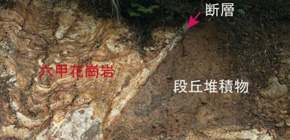
Presence of amorphous ultrafine particles shows fault activity within 1,000 years
Will become a new method for assessing fault activity
A group of researchers led by Associate Professor HIRONO Tetsuro at the Graduate School of Science, Osaka University, focused on amorphous ultrafine particles in faults to examine their dissolution rate, proposing a new method using a proxy for assessing the recent activity of a fault: the presence of relatively abundant amorphous ultrafine particles in fault material strongly suggests that the fault slipped sometime in the last 1,000 years.
Observing and analyzing fault samples in the Arima-Takatsuki Tectonic Line, which last slipped during the 1596 Keicho-Fushimi earthquake, this group discovered that a large amount of amorphous ultrafine particles several tens of nanometres in size were present compared to stones in the surrounding areas.
By referencing the dissolution rate of amorphous ultrafine particles from values in literature, this group examined how long they would be kept under local environmental conditions (temperatures and pH) and found that they would completely disappear in about 1,000 years, i.e., dissolve into groundwater. This means that the presence of relatively abundant amorphous ultrafine particles in the fault suggests that the fault slipped sometime in the last 1,000 years.
The conventional criterion for assessing faults and crushed zones was the presence of displacement by faulting of Quaternary strata of known sedimentary age near the surface of the ground. However, in cases where Quaternary strata of known sedimentary age was eliminated because of land leveling for building construction and these strata were not exposed in the investigation of lateral extension of the crushed zone, the evaluation of the site was almost impossible.
Even in such cases, as shown in this study, through the confirmation of the presence of amorphous ultrafine particles and the kinetic analysis of dissolution reaction including environmental conditions at the site, it will become possible to establish fault activity in the last 1,000 years. Moving forward, it is hoped that recent fault activity can be estimated by examining the influence of minerals in faults through verification of other faults that caused great earthquakes in the past and by conducting experimental determination of dissolution rates of samples from different faults.
There are many faults in continents at home and abroad and it’s necessary to review their influence on big cities and important artificial structures such as nuclear power plants, chemical plants, and oil plants, with evaluation of activity of crushed zones under the premises of nuclear power plants a particularly urgent issue. Through verification of other faults and indoor experiments, this new evaluation method focusing on amorphous ultrafine particles in active slip zones during earthquakes will become a solution for this issue and it is also hoped that this method will be applied to the evaluation of faults in Japan and abroad.
Abstract
The criteria for designating an “Active Fault” not only are important for understanding regional tectonics, but also are a paramount issue for assessing the earthquake risk of faults that are near important structures such as nuclear power plants. Here we propose a proxy, based on the preservation of amorphous ultrafine particles, to assess fault activity within the last millennium. X-ray diffraction data and electron microscope observations of samples from an active fault demonstrated the preservation of large amounts of amorphous ultrafine particles in two slip zones that last ruptured in 1596 and 1999, respectively. A chemical kinetic evaluation of the dissolution process indicated that such particles could survive for centuries, which is consistent with the observations. Thus, preservation of amorphous ultrafine particles in a fault may be valuable for assessing the fault’s latest activity, aiding efforts to evaluate faults that may damage critical facilities in tectonically active zones.
Figure 1
Figure 2
Figure 3
To learn more about this research, please view the full research report entitled “ Preservation of amorphous ultrafine material: A proposed proxy for slip during recent earthquakes on active faults ” at this page of the Scientific Reports website.
Related link
